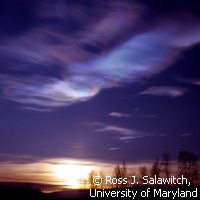Unusually low Arctic temperatures causing ozone depletion
EU-funded researchers have discovered that unusually low temperatures in the Arctic ozone layer have triggered large-scale ozone depletion. The findings show that the Arctic could soon experience much less protection from the sun's damaging ultraviolet rays if a record loss of ozone layer deterioration has occurred. The study was funded by the RECONCILE ('Reconciliation of essential process parameters for an enhanced predictability of arctic stratospheric ozone loss and its climate interactions') project, which was backed with EUR 3.5 million under the 'Environment' Thematic area of the EU's Seventh Framework Programme (FP7). Coordinated by the Potsdam Research unit of the Alfred Wegner Institute for Polar and Marine Research in the Helmholtz Association (AWI) in Germany, the project involved 16 research institutions from 8 Member States and over 30 ozone sounding stations situated all over the Arctic and Subarctic. The overall aim is to understand the details that remain unclear surrounding the complicated relationship between the ozone layer and climate change. There are many issues surrounding ozone layer depletion that remain a mystery, such as how processed air is mixed and transported to lower altitudes. AWI researcher Dr Markus Rex commented: 'Our measurements show that at the relevant altitudes about half of the ozone that was present above the Arctic has been destroyed over the past weeks. Since the conditions leading to this unusually rapid ozone depletion continue to prevail, we expect further depletion to occur.' Ozone depletion occurs when products of anthropogenic chlorofluorocarbons (CFCs) are broken down by sunlight and turned into aggressive, ozone-destroying substances during exposure to extremely cold conditions. The link between ozone loss and climate change has long been established and nowhere is this more evident than in the Arctic, where the coldest winters keep getting colder leading to larger ozone losses. As greenhouse gas concentrations increase and the Earth's thermal radiation is kept at lower layers of the atmosphere, these layers heat up. Less of the heat radiation reaches the stratosphere, which intensifies the cooling effect and leads to greater ozone depletion. Yet it is not only in the Arctic where these changes are having an impact. Air masses exposed to ozone loss above the Arctic can also drift southwards, meaning the thinning ozone layer will offer less UV protection in middle latitudes too. The researchers are therefore warning Europeans to pay particular attention to protecting themselves from UV rays when out and about in the sun this spring. The good news is that thanks to the Montreal Protocol, an international treaty adopted in 1987 to protect the ozone layer by banning the worldwide production of CFCs, significant ozone destruction will no longer occur during the second half of this century. However, CFCs released during prior decades will not vanish from the atmosphere for many decades to come. This means that in the long term the ozone layer will recover thanks to these extensive environmental policy measures. Until that time, the fate of the Arctic ozone layer depends on the ozone layer's temperature at an altitude of around 20 km and is therefore linked to the Earth's climate. The findings from the RECONCILE project will be published in a forthcoming paper. The RECONCILE project uses a comprehensive approach that includes laboratory and field experiments together with microphysical and chemical transport modelling. By producing and testing reliable parameterisations of the key processes in Arctic ozone layer depletion and bridging them to large scale chemistry climate models (CCMs), the researchers can increase their chances of making realistic predictions about the future evolution of Arctic ozone layer loss and its interaction with climate change. For more information, please visit: Alfred Wegener Institute: http://www.awi.de
Countries
Belgium, Canada, Switzerland, Czechia, Germany, Denmark, Greece, Spain, Finland, France, Norway, Russia, United Kingdom, United States



